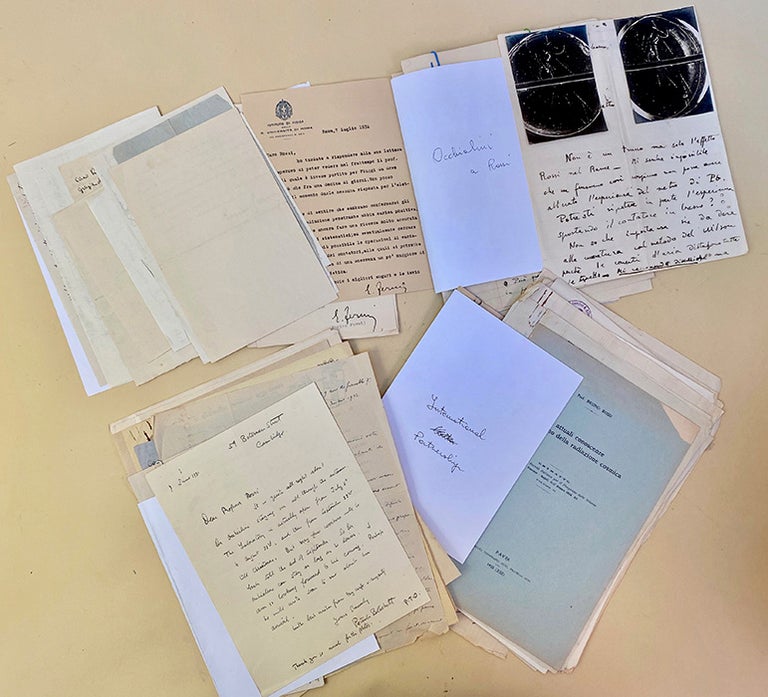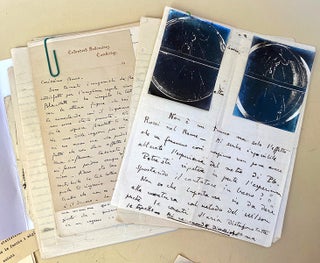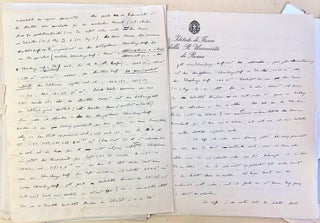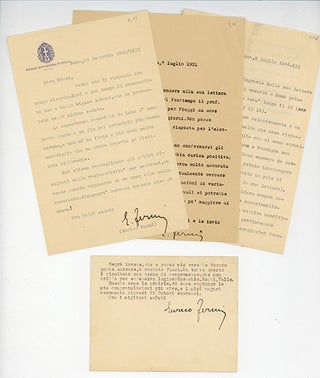Archive of correspondence to experimental physicist Bruno Rossi
Publisher Information: 1931-35.
Fermi, Enrico (1901-54) et al. Archive of scientific correspondence to Bruno Rossi (1905-93) plus related materials; calendar of archive available on request. 68 items total. 1930-36. Various sizes. Rust-stains from paper clips on some items, a few minor chips and marginal tears, but very good.
An extraordinary archive of scientific correspondence, written to Italian experimental physicist Bruno Rossi, one of the founders of the study of cosmic rays and a major contributor to particle physics. In addition to four letters from Fermi, the archive includes correspondence from Nobel laureates Hans Bethe, Patrick Blackett, John D. Cockcroft, and Emilio Segrè, as well as letters from Lise Meitner, Hans Geiger, Homi J. Bhabha, Yoshio Nichina, and Rossi’s student Giuseppe Occhialini. The materials in the archive date from the period 1930 to 1936, the time when Rossi did some of his most important and fruitful work on cosmic radiation.
As a young physics professor at the University of Florence, Rossi read Walther Bothe and Werner Kolhörster’s 1929 paper announcing the existence of charged cosmic ray particles that could penetrate gold by more than four centimeters—far more than any other form of radiation known at the time. Inspired by this astonishing discovery, Rossi decided to devote his career to studying cosmic radiation. In 1930, using triode vacuum tubes, Rossi invented an electronic coincidence circuit for detecting charged cosmic particles, a vast improvement over the cumbersome apparatus used by Bothe. Rossi and his student Giuseppe Occhialini used the new device, in conjunction with the improved Geiger-Müller particle detector, to confirm Bothe’s investigations and to perform important new research.
"In 1930, Bruno Rossi used electronic valves to register coincident pulses from the Geiger counters. He arranged the detectors in a triangle so that the cosmic rays could not transverse all three counters. In 1932 he found that 60% of the cosmic rays that pass through the 25 cm piece of lead could also traverse a full metre of lead. This was the first demonstration of the production of showers of secondary particles. Rossi also demonstrated that the cosmic ray flux contains a soft component easily absorbed in a few millimeters of lead and a hard component of charged particles with energies above 1 GeV. This ended Millikan’s theory that the cosmic rays consisted of gamma rays.
"Rossi demonstrated that the Earth’s magnetic field bends incoming charged particle showers so that if they are more negative, more come from the east than from the west and vice-versa. In 1933, Rossi and others demonstrated an east-west effect that showed that the majority of cosmic rays were positive" (“CERN Accelerating Science.” Bruno Rossi: Cosmic Rays Are Positive Charged Particles, CERN [web]).
The most illustrious of the physicists represented in the Rossi archive is Enrico Fermi, who received the Nobel Prize in 1938 for his work on induced radioactivity by neutron bombardment, and four years later built the world’s first man-made nuclear reactor, which made possible the development of the atomic bomb. The earliest of the Fermi letters in this collection, dated 7 July 1931, deals with Rossi’s cosmic ray research (all translations ours):
“. . . I am pleased to hear that the indications that penetrating radiation has a positive charge seem to be confirmed; of course, a very careful search for possible systematic errors should still be made; and possibly try to mechanize as much as possible the operations of variations in the counters’ potential, to which one could attribute the causes of a consistency a bit greater than the purely statistical . . ."
Fermi’s postcard of 30 October 1932, together with the telegram dated the following day, congratulated Rossi for being one of three winners of the science competition sponsored by the University of Ferrara, in which Fermi was one of the judges:
"I am pleased to inform you that the Ferrara competition, which was virtually decided yesterday evening, had a favorable outcome for you, who came in second, having had two votes for first place . . . On the other hand, Segrè, who in my opinion should have also gotten in, was left out . . ."
In his letter of 8 July 1934, Fermi responded to Rossi’s request for suitable theoretical physicists to fill positions at the University of Padua’s new Physics Institute, which Rossi was overseeing:
". . . As far as being asked about a theoretical physicist, I don’t know what to answer. In my opinion the best that are currently on the marked are [Gian Carlo] Wick and [Giulio] Racah; but I wouldn’t believe they want to move from where they are, although I haven’t been able to ask them about it . . . Ettore Majorana, whom I always consider to have very exceptional attitudes, has been in poor health this year . . . Among the very best perhaps the best of those I know is Eugenio Fubini . . ."
The fourth Fermi letter, dated 20 February 1935, refers to a paper by Rossi and Giulia Alocco, as well as an experiment by physicist Wilhelm Lenz and Fermi’s own work on slow neutrons:
". . . The experiment described by Lenz seemed to me from the beginning to be rather strange, and it did not surprise me very much that you found a different result.
"We are collecting the latest results on neutron radioactivity, but this topic is also gradually being exhausted. We will have to look for something new!"
Another highlight of the Rossi archive is a series of 13 detailed scientific letters (some illustrated with photographs or drawings) from his first graduate student, Giuseppe Occhialini (1907-93), describing the research Occhialini was doing under Patrick Blackett at Cambridge University’s Cavendish Laboratory. Occhialini spent three years (1931-34) at the Cavendish, during which he performed important work on cloud chambers and cosmic radiation; in 1932, under Blackett’s leadership, Occhialini collaborated in the discovery of the positron in cosmic rays. Occhialini was an important protagonist in the use of photographic methods to study nuclear processes, most notably in 1946 when he collaborated with Cecil Frank Powell and César Lattes in the discovery of the pion. See the exceptionally comprehensive article on Rossi in the Wikipedia.
Book Id: 45179Price: $37,500.00




